The characteristic of a material to resist the flow of current through it, is known as resistance.
When any element is subjected to an electrical potential difference or a voltage difference you will find an electric current trying to move through the element.
The voltage applied over the element will be directly proportional to the current passing through it, and the resulting constant of proportionality is referred to as resistance. Therefore resistance is defined as the ratio of applied voltage to the current through the substance.
Principle of Resistance
To comprehend the situation, we will consider examples of metallic elements. You will find lots of free electrons switching arbitrarily within the crystal framework of all metallic elements.
When we introduce a voltage difference over the ends of a resistance, due to the resulting electric field the free electrons begin shifting through lower potential level to higher potential level within the material.
In the course of this shifting movements, the free electrons continuously keep colliding with atoms in the material, and this phenomenon creates an opposition to the movement of the free motion of electrons, giving rise to the parameter called resistance.
Unit of Resistance
From the description of resistance, we can conclude that the unit of an electrical resistance is volt per ampere. A single unit of resistance is that resistance which forces 1 ampere current to push through it when the particular resistance is subjected to a potential difference of 1 volt across it. This unit volt per ampere is referred to as ohm(Ω) named after the popular German physicist George Simon Ohm.
∴ 1 volt / 1 ampere = 1 Ohm (Ω)
Unit of Resistance
From the description of resistance, we can conclude that the unit of an electrical resistance is volt per ampere.
A single unit of resistance is that resistance which forces 1 ampere current to push through it when the particular resistance is subjected to a potential difference of 1 volt across it.
This unit volt per ampere is referred to as ohm(Ω) named after the popular German physicist George Simon Ohm.
The unit ohm is generally useful for modest values of resistance however there could possibly be an exceptionally substantial and also a tiny magnitudes of resistance utilized for various requirements.
Such magnitudes are depicted in giga-ohm, mega ohm, kilo-ohm, milli-ohm, micro-ohm even in nano-ohm range with respect to the magnitude of resistance.
Resistances diverse Substances
Based on the value of resistance, substances could be segregated into 3 groups.
You will find a few substances primarily metallic substances that provide surprisingly low resistance to the current passing through them. These types of substances are known as conductors more specifically electrical conductors.
- Silver is definitely an very good conductor of electricity however it is not widespread in power systems owing to its high cost. Aluminum is an effective conductor and it is frequently used conductor due to its affordable price and their abundant nature.
- Copper is yet another excellent conductor widely used in various electronics and electrical circuits and it is a significantly better conductor compared to aluminum although it is a bit more expensive than aluminum.
- There exists yet another class of elements known as semiconductor. These possess a average value of resistance which means resistance not so large and also not too low in ambient room temperature.
- You will find countless utilities associated with semiconductors in the field of electronic devices manufacturing. Silicon, germanium are generally a couple of widely implemented semiconductor elements. Besides, these such types of compounds also work as semiconductors.
- The elements which present intense resistance to the current is recognized as insulators or electrical insulating substance. All these resources are incredibly poor conductor of electricity and largely employed to protect against leakage current in electrical solutions.
- Papers, dried out timber, mica, porcelain, backelite, glass epoxy polyester, mineral oil, SF6 gas, Nitrogen gas, other gases, air, etc are really great instances of insulation materials.
Influence of Temperature on Resistance
When metallic materials are subjected to increasing temperature their interatomic oscillations maximize and therefore begin delivering increasing resistance to the motion of electrons, leading to reduction in current flow.
Therefore, with escalating temperature the resistance of metallic ingredients proportionately increases. The temperature coefficient of resistance is positive for all metallic substances.
In semiconductors as temperature increases the quantity of free electrons also increases since higher temperature causes greater quantity of covalent bonds to break apart and add up free electrons in the material. This action minimizes the resistance of the material. For this reason semiconductors have a negative temperature coefficient of resistance.
